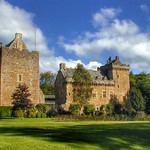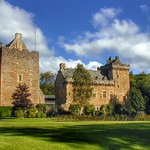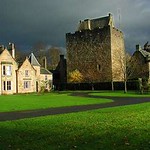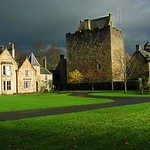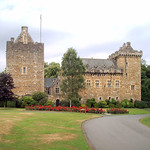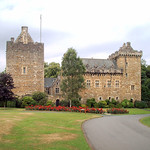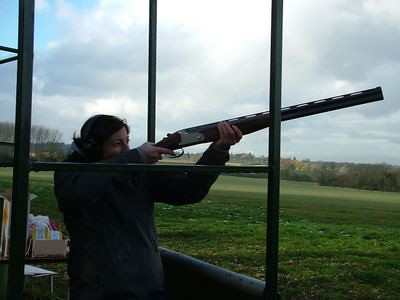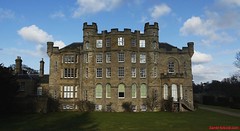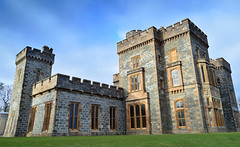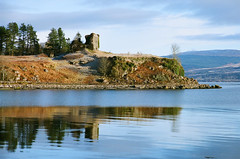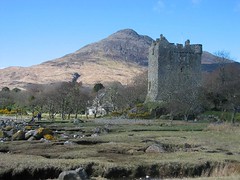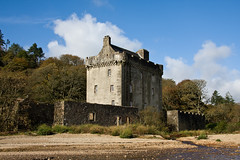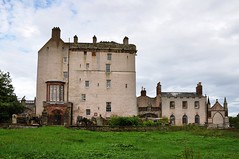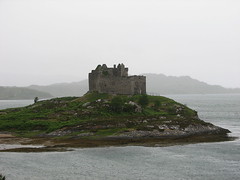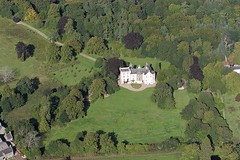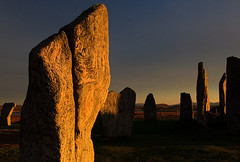Dean Castle
Well preserved stronghold of the Boyd Family who were given these lands by the Bruce. The castle contains a 14thC keep and latrer 15thC palace block as well as later 17thC additions. The surrounding country park is open daily as well and makes day out with kids. The musical instrument collection is outstanding.
Dean Castle takes its name from ‘The Dean’ or wooded valley – a common place name in Scotland. The original keep dates from around 1350 with the Palace being added around 110 years later. Built by the Boyd family, it has strong historical connections with many people and events in Scottish history – Robert the Brucewho gave the lands to the Boyds, James IIIwhose sister married a Boyd, the Covenanters – some of whom were imprisoned there, Bonnie Prince Charlie – whose rebellion was joined by the 4th Earl of Kilmarnock and Robert Burnswho was encouraged to publish his poems by theEarl of Glencairn who owned the castle at the time.
Around 1290, the English committed an atrocity in Ayr by hanging a number of Scottish nobles. It is believed that Sir Robert Boyd was amongst the murdered men along with members of the Wallace family. As a result of this action Boyd’s son (also Sir Robert) joined forces with William Wallace and other Scottish patriots to fight for Scottish independence. He took part in “The Burning of the Barns of Ayr” where the English forces were either burned alive or slaughtered. He also took part in a battle with the English at Loudoun Hill outside Darvel. It is also thought that Sir Robert Boyd was present at the Battle of Falkirk where Wallace was defeated.
After Wallace was executed, Sir Robert Boyd was then one of the first supporters of Robert the Bruce and was trusted enough to act as his queen’s escort in 1306. In 1316, Robert the Bruce gave him the Lordship of Kilmarnock for his support during the Battle of Bannockburn. He was finally captured by an English army at Halidon Hill in 1333 and died soon after. The English however, due to the efforts of Boyd and others like him, were never able to gain a strong foothold in Scotland again. His son, Sir Thomas Boyd of Kilmarnock probably completed the building of the keep of Dean Castle before being captured with King David II in 1346 and suffering a period of imprisonment in England. The Boyd family were to live at Dean Castle for the next 400 years.
The 8th Lord Howard de Walden (Thomas Evelyn Ellis) inherited the castle in 1899 and spent many years restoring the castle as it had suffered over two centuries of neglect after being gutted by fire in 1735. The restoration of the Keep was completed in 1908 and the Palace in the 1930’s. Lord Howard De Walden was a man of many talents – he wrote books and plays and had a keen interest in music and art. His other passions included horse racing (both as an owner and breeder) and fencing ( he was a reserve for the Olympic team in 1906). He collected some of the countries finest collections of swords, weapons and armour which are now housed within Dean Castle.
Lord Howard De Walden was married to Margherita Van Raalte, the daughter of a Jewish Dutch immigrant, Charles Van Raalte, who is responsible for the finest collection of historical musical instruments anywhere in Europe. This collection is also housed within Dean Castle. Lord Howard De Walden and his wife spent a lot of time at their Scottish home and chose to be buried here as is Lord Howard De Walden’s mother - Blanche. He died in 1946 and was succeeded by his son – the Right Honourable John Osmael Scott Ellis as the 9 th Lord Howard De Walden and Seaford. In 1974, he gifted the castle and its collections to the people of Kilmarnock and in 1976 the castle was opened to the public. The collections of Arms & Armour, historical musical instruments and tapestries are some of the finest anywhere in Europe.
Opening Times
Open Daily


